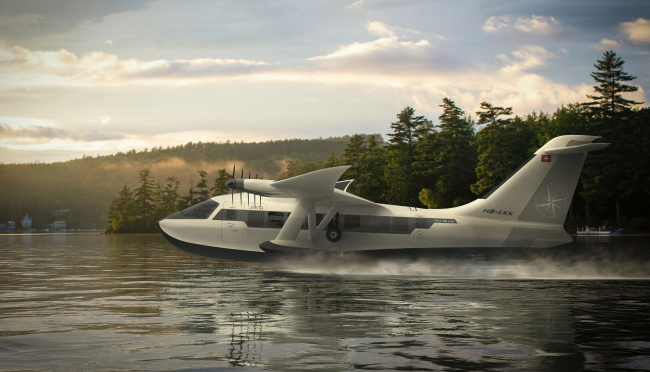
Swiss-based Jekta plans to avoid traditional infrastructure development costs by operating its PHA-ZE 100 zero emissions aircraft from water.
DUBLIN—With a growing number of aircraft progressing toward certification, infrastructure is becoming the dominant preoccupation of the advanced air mobility (AAM) and electric aviation industry, speakers at Revolution.aero’s European conference said this week.
As test flights ramp up and regulators assess platforms ahead of initial proof-of-concept operations, questions of where these new aircraft will fly to and from and who will fly them are emerging as critical concerns. Indeed, these may become brakes on the sector’s growth, various speakers suggested during the two-day event.
“There are about 300 vertiport projects out there which have been announced,” said Stephan Baur of Munich-headquartered management consultancy Roland Berger. “However, if you look at the current eVTOLs [electric-vertical-takeoff-and-landing aircraft] on order, we would need at least 1,500 vertiports globally. That’s really a huge gap—and this gap is also across all regions at the moment.”
The ecosystem required goes far beyond the vertiport, though.
“We need to have additional digital infrastructure,” Baur said. “We need to have unmanned traffic management. We need to have booking platforms. We need to have integration with the existing transport ecosystem. There’s a lot which needs to be orchestrated.”
The needs may be clear, but there are differences in approaches to how, when and where to place facilities capable of handling eVTOL platforms. For some, location is more important than anything else. For others, gaining real-world experience is paramount.
“In my view, the best thing a vertiport company can do at the moment is to secure options on sites,” said Clem Newton-Brown, founder of Australian startup Skyportz. “Some very clever people are spending lots and lots of time building amazing aircraft, but if all you’re doing is flying those aircraft from airports to helipads? It’s nice. You’ve got a cleaner, quieter helicopter, but there’s no transport revolution.”
Duncan Walker, founder of British-based Skyports, is concentrating instead on construction and implementation. The company is working with aircraft OEMs and local authorities to understand the requirements of the vehicles and the operating environment.
“It’s really important to physically build vertiports to get the whole thing going,” Walker said. “You don’t really learn anything unless you’ve built them and done them. We’ve got airport planners, we’ve got regulators, we’ve got a technology team, we’ve got scheduling, we’ve got resource management people, we’ve got capacity modelers. This is a sophisticated airport business that’s really trying to guide the industry forward.”
Another panel discussed AAM pilots. Training requirements are still a work in progress. Julie Garland, founder and CEO of drone training and certification body Avtrain, does not expect pilot certification standards to be published before 2025. Yet the numbers required will be vast. While many AAM OEMs and operators are looking at future business models that depend on autonomy to achieve profitability, initial operations carrying fare-paying passengers will only be possible with pilots on board. Whether this will be a career progression for drone pilots, a late career change for experienced airliner crews, a sidestep for helicopter pilots, or a totally new career field set to be dominated by ab initio specialists, has also yet to be determined, Garland said.
Short-range flights by small eVTOL platforms imply the capability to recharge at both ends of the journey. But proponents of hybrid or hydrogen-fueled regional aircraft argue that their systems offer greater flexibility. James McMicking, strategy vice president of British-American hydrogen powertrain startup ZeroAvia, suggested that, for operators of hub-and-spoke networks, having hydrogen available everywhere would not be necessary. The company’s in-development ZA2000 powerplant will be retrofitted to 40-80 seat regional turboprops. Even though this will reduce the platform’s maximum range by half, the retrofitted aircraft would still be capable of carrying out “above 98%” of the current fleet’s roundtrip missions on a single load of hydrogen.
“To get the ball rolling, you don’t need to put hydrogen infrastructure at every node [of the network],” McMicking said. “You need to put it at one end of these missions in order to provide your customer with the fuel to cover both directions of flight.”
There may even be opportunities to develop new infrastructure in areas currently considered unusable. Swiss-based Jekta is building a carbon-composite, electrically powered 19-seat flying boat, while U.S. startup Regent is developing an electrically powered seaglider which flies so close to the water’s surface that it will be regulated by the International Maritime Organization rather than an aviation agency.
“If you want to be an operator in Indonesia or Brazil or the United States, and you don’t want to invest a huge amount of money in building vertiports or airports, you can use water,” said Jekta’s founder and CEO, George Alafinov. “Additionally, building any infrastructure on land has an irreversible ecological impact—and water is right there. It’s very easy, it’s ready to be used. All you need is a proper machine to use it for your transport needs, whether it’s cargo or passengers.”
